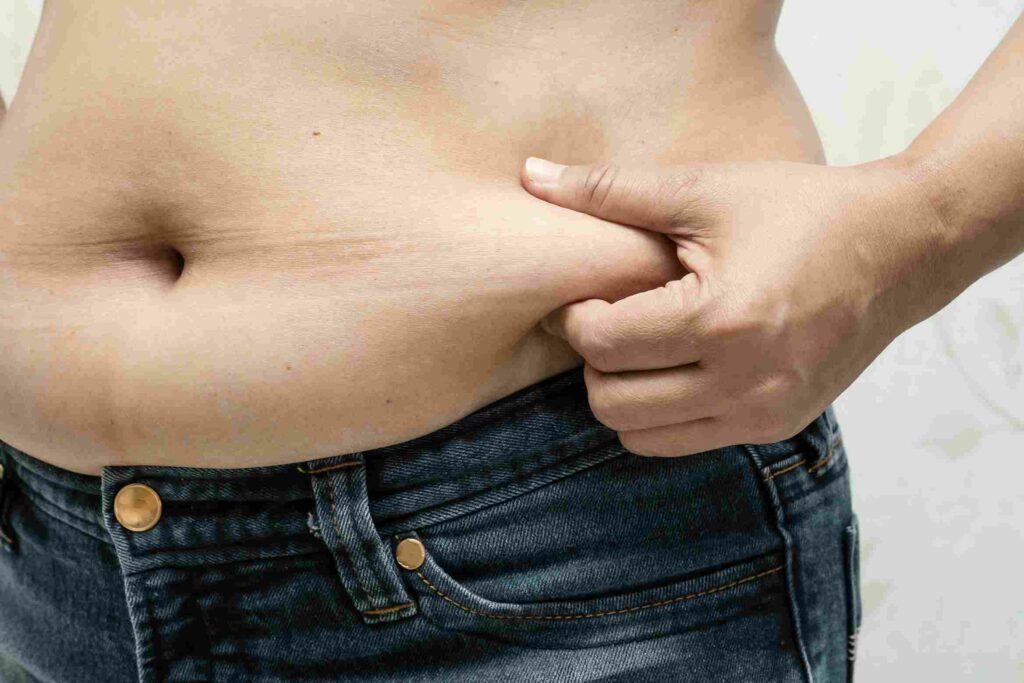Do you have a bit of a belly? Are you concerned about the different types of belly fat and how to get rid of them? You’re not alone. A lot of people are struggling with this issue. In this blog post, we will discuss the different types of belly fat and how to get rid of them, and how to maintain a healthy weight.
Contents
Types Of Belly Fat
 Here is a comprehensive list of belly fats and how you can get rid of them:
Here is a comprehensive list of belly fats and how you can get rid of them:
- Visceral Fat: This kind of fat is found around your internal organs and has links to metabolic diseases like type 2 diabetes and heart disease. To reduce visceral fat, you need to make lifestyle changes such as eating a healthy diet low in processed foods, exercising regularly, getting enough sleep, reducing stress levels, and limiting alcohol intake. Additionally, a study published in 2017 found that taking omega-3 supplements can help reduce visceral fat.
- Subcutaneous Fat: This type of fat is found underneath the skin and has a more direct link with weight gain. To reduce subcutaneous fat, you need to focus on reducing your overall body fat percentage by eating a balanced diet and engaging in regular exercise. Moreover, anaerobic exercises such as weight training are especially helpful in targeting specific areas of the body, including belly fat.
How To Lose Belly Fat?
Here are 5 ways to lose visceral and subcutaneous fat.
Eat a healthy, balanced diet
Here are 10 foods and beverages to help you lose belly fat:
Whole grain
Whole grains like oats and quinoa are rich in fiber and B vitamins, which help reduce visceral fat. Just 100 grams of oats contain 8.2 grams of fiber and 11.3 milligrams of B vitamins. Additionally, they are low in calories and fat, making them an ideal choice for weight loss.
Legumes
Beans, peas, and lentils are great sources of protein, fiber, and a variety of other nutrients that help reduce visceral fat. Just half a cup of cooked chickpeas contains 4.4 grams of fiber and 7.5 grams of protein. Moreover, legumes are rich in plant-based omega-3 fatty acids, which have been linked to lower cholesterol levels and a reduced risk of heart disease.
Fruits
 Fruits are rich in vitamins, minerals, and antioxidants that can help reduce visceral fat. Berries like strawberries and blueberries are especially beneficial for reducing belly fat because of their high fiber and antioxidant content. Just 100 grams of an apple contains 4.4 grams of fiber and 13 milligrams of vitamin C. Furthermore, many fruits are naturally low in calories and fat, making them a great choice for weight loss.
Fruits are rich in vitamins, minerals, and antioxidants that can help reduce visceral fat. Berries like strawberries and blueberries are especially beneficial for reducing belly fat because of their high fiber and antioxidant content. Just 100 grams of an apple contains 4.4 grams of fiber and 13 milligrams of vitamin C. Furthermore, many fruits are naturally low in calories and fat, making them a great choice for weight loss.
Vegetables
Eating plenty of vegetables is essential for reducing visceral fat. Vegetables like broccoli, spinach, and kale are rich in fiber and vitamins that can help reduce belly fat. Just 100 grams of broccoli contains 2.6 grams of fiber and 54 milligrams of vitamin C. Additionally, they contain antioxidants that can protect your body from free radicals.
Fish
Fish are rich in protein and omega-3 fatty acids, both of which can help reduce visceral fat. Just 100 grams of salmon contains 21.1 grams of protein and 1.2 grams of omega-3s. Additionally, fish is low in calories and saturated fat, making it an ideal choice for weight loss.
Nuts and Seeds
Nuts and seeds are rich in protein, fiber, and healthy fats that can help reduce visceral fat. Just 100 grams of almonds contain 21.2 grams of protein, 12.5 grams of fiber, and 49.7 milligrams of vitamin E. Additionally, nuts and seeds are a great source of plant-based omega-3 fatty acids, which have been linked to improved heart health.
Coconut Oil
Coconut oil is high in medium-chain triglycerides (MCTs), which have been shown to help reduce visceral fat. Just one tablespoon of coconut oil contains 11 grams of MCTs. Additionally, it’s a great source of healthy saturated fat that can help keep you full for longer and reduce hunger cravings.
Fermented Foods
Fermented foods like kimchi and sauerkraut are rich in probiotics that can help reduce visceral fat. Just 100 grams of kimchi contains 1.7 billion colony-forming units (CFUs) of probiotics. Additionally, these foods are also packed with vitamins, minerals, and antioxidants that can help protect your body from free radicals.
Green Tea
Green tea is rich in catechins, a type of antioxidant that has been linked to reduced belly fat. Just one cup of green tea contains 40 milligrams of catechins. Additionally, it’s low in calories and caffeine, making it an ideal choice for weight loss.
Greek Yogurt
Greek yogurt is a great source of protein and calcium, both of which can help reduce visceral fat. Just one cup of Greek yogurt contains 17 grams of protein and 20% of the recommended daily intake (RDI) for calcium. Additionally, it’s low in calories and saturated fat, making it an ideal choice for weight loss.
Exercise regularly
Here are 10 exercises you can do to lose your belly fat, and how to do them:
Jumping jacks
This is an excellent exercise for burning fat and improving overall cardiovascular health. Begin by standing with your feet hip-width apart and your arms at your sides. Jump up, spreading your feet out to the side and raising your arms above your head. Then jump back to the starting position. Do this for 1 minute at a time.
Squats
This exercise targets the muscles in your lower body, including your core and glutes. Begin by standing with your feet hip-width apart and your arms out in front of you. Lower yourself into a squat position, then stand back up again. Do this for 1 minute at a time.
Pushups
This exercise works the muscles in your chest, shoulders, and arms while also engaging your core. Begin by lying on your stomach with your hands beneath your shoulders and elbows bent. Push yourself off the floor until both arms are straightened out. Then lower yourself back down to the starting position. Do this for 1 minute at a time.
Sit-ups
This is a great exercise for toning your abdominal muscles and reducing belly fat. Begin by lying on your back with your knees bent and feet flat on the floor. Take a deep breath in, then exhale as you lift your upper body off the floor towards your knees. Then lower yourself back down to the starting position. Do this for 1 minute at a time.
Lunges
This exercise targets the muscles in your lower body, including your glutes, hamstrings, and calves. Begin by standing with your feet hip-width apart and arms at your sides. Step forward with one foot and bend both legs into a lunge position. Make sure to keep your knee behind or over the toe of that foot. Then step back to the starting position. Do this for 1 minute at a time.
Burpees
This is an effective full-body workout that combines cardio and strength training. Begin by standing with your feet hip-width apart and arms at your sides. Squat down and place your hands on the floor in front of you, then kick both legs out behind you into a plank position. Return to the squatting position, then stand up and jump up into the air, clapping your hands above your head. Do this for 1 minute at a time.
Bicycle crunches
This exercise targets your abdominal muscles while also working your obliques and lower body muscles. Begin by lying on your back with your knees bent and feet flat on the floor. Place your hands behind your head and lift your shoulders off the ground as you twist to bring one elbow towards the opposite knee. Then alternate sides, bringing the other elbow towards the other knee. Do this for 1 minute at a time.
Plank
Begin by lying on your stomach with elbows bent and palms flat on the ground beneath your shoulders. Lift yourself up onto your toes and forearms so that only your toes, forearms, and elbows are touching the ground. Hold this position for 30-60 seconds at a time.
Mountain climbers
Great exercise for burning calories and increasing muscular endurance. Begin in a plank position, then bring one knee to your chest at a time as if you were running in place. Do this for 1 minute at a time.
High knees
This is an effective cardio exercise for burning fat and improving your overall cardiovascular health. Begin by standing with your feet hip-width apart and hands at your sides. Quickly bring one knee up towards the chest, then switch to the other leg and repeat. Do this for 1 minute at a time.
Get enough sleep
 Here are 10 ways to get good quality sleep:
Here are 10 ways to get good quality sleep:
- Stick to a sleep schedule: Go to bed and wake up at the same time each day, including on weekends.
- Avoid electronics before sleeping: Put away your phones and laptops an hour or two before bedtime so that you can relax and prepare for sleep
- Try relaxing activities before bed: Reading, taking a warm bath, or doing some light stretching are all great ways to relax and prepare your body for sleep.
- Exercise regularly: Regular exercise can help improve the quality of your sleep by reducing stress and releasing endorphins. Just make sure not to exercise too close to bedtime as it can make it harder to fall asleep.
- Avoid caffeine and alcohol before bed: Caffeine and alcohol can both interfere with the quality of your sleep, so try to avoid them for at least 4-6 hours before you plan to go to bed.
- Reduce stress: Stress can make it harder to fall asleep, so practice relaxation techniques like yoga or meditation before bedtime to help you relax.
- Create a comfortable sleeping environment: Make sure your bedroom is dark, quiet, and cool for optimal sleep conditions.
- Eat a light snack before bed: Eating a small, healthy snack like yogurt or fruit can help you get to sleep faster and stay asleep longer.
- Avoid drinking too much water before bed: Drinking too much water can make you wake up to use the bathroom during the night, interrupting your sleep.
- Talk to a doctor if necessary: If you are still having trouble getting good quality sleep, it may be best to consult a doctor for advice on how to get better rest.
Reduce stress levels
 Here are 10 ways you can reduce your stress levels:
Here are 10 ways you can reduce your stress levels:
- Exercise: Regular exercise can help reduce stress and improve your overall well-being.
- Breathe deeply: Taking deep breaths can help you relax and slow down your heart rate, allowing you to better manage stressful situations.
- Get organized: Having an organized environment and schedule can help reduce stress as it leaves less room for confusion and disorganization.
- Avoid multitasking: Focusing on one task at a time can help reduce stress levels as it prevents you from feeling overwhelmed by multiple tasks.
- Get enough sleep: Sleep deprivation can increase stress levels, so make sure to get 7-9 hours of quality sleep each night.
- Talk to a friend: Talking with a friend or family member can help you de-stress by allowing you to vent your feelings and receive support from someone who cares about you.
- Take breaks: Taking short breaks throughout the day can help reduce stress levels as it gives you time away from whatever is causing the stress.
- Eat healthy foods: Eating nutritious foods can help reduce stress levels as it provides your body with the necessary nutrients it needs to function properly.
- Avoid alcohol and caffeine: Alcohol and caffeine can both increase stress levels, so try to limit them as much as possible.
- Practice relaxation techniques: Relaxation techniques like yoga and meditation can help reduce stress levels and promote a more peaceful state of mind.
Limit alcohol consumption
Here are 10 tips to help you limit your alcohol consumption:
- Set a limit for yourself: Before going out, decide on the maximum amount of drinks you will have and stick to it.
- Alternate between alcoholic and non-alcoholic drinks: Alternating between alcoholic and non-alcoholic beverages can help reduce your overall intake while still allowing you to enjoy the occasion.
- Try new activities: Participating in activities that don’t involve alcohol can be a great way to socialize without having to drink.
- Make healthier choices: When drinking, choose lower-calorie or low-alcohol options like light beer or wine spritzers instead of sugary cocktails or hard liquor.
- Have a snack before going out: Eating something substantial before heading out for the night can help reduce your temptation to overindulge in alcohol.
- Drink water: Drinking plenty of water throughout the night can help keep your body hydrated and reduce your alcohol consumption.
- Stop drinking when you’ve had enough: If you start to feel too drunk, take a break from drinking anymore and switch to non-alcoholic beverages instead.
- Avoid peer pressure: Resist peer pressure by politely declining drinks that are offered to you or reminding people of your limit if they try to push it further.
- Find alternatives to going out: Instead of going out for drinks, consider planning an activity that doesn’t involve alcohol like going bowling, playing board games, or having a movie night with friends.
- Get help if needed: If you think your drinking has become a problem, talk to a doctor or another trusted health professional for help.
Increase your fiber intake
Here are 10 tips to help you increase your fiber intake:
- Eat whole grains: Incorporating more whole grain products like oatmeal, brown rice, and whole wheat bread into your diet can help boost your fiber intake.
- Add fruits and vegetables: Eating more fresh fruits and vegetables is a great way to get additional dietary fiber in your meals.
- Choose high-fiber cereals: Look for cereals that contain at least 5 grams of dietary fiber per serving.
- Have beans with meals: Incorporate beans such as pinto, kidney, or black beans into your meals to increase the amount of fiber you’re consuming.
- Use ground flaxseed: Adding ground flaxseed to smoothies or other dishes is another easy way to increase your daily fiber intake.
- Snack on nuts: Eating a handful of nuts is a healthy and tasty way to get additional dietary fiber.
- Include chia seeds: Sprinkling chia seeds over salads or yogurt can help boost your daily fiber intake.
- Swap white rice for brown rice: Brown rice is generally higher in fiber than white rice, so opt for this option when possible.
- Have popcorn as a snack: Air-popped popcorn is naturally high in fiber, making it an ideal snack option.
- Read food labels: Look out for products labeled ‘high fiber’ or that contain at least 5 grams of dietary fiber per serving.
Conclusion
Belly fat is a common problem for many people and there are various types of belly fat. As most belly fat is caused by lifestyle factors such as diet and exercise, making healthy changes to your lifestyle can help reduce or prevent excessive abdominal fat accumulation.
Consider contacting FitMantra for additional information on nutrition and fitness. You can also get in touch with their nutrition experts through our online nutrition counseling, who can guide you through the process and help you achieve your fitness goals. You can also lose weight with the help of our weight loss program. Download our Fitness app on Android to learn more about us.
